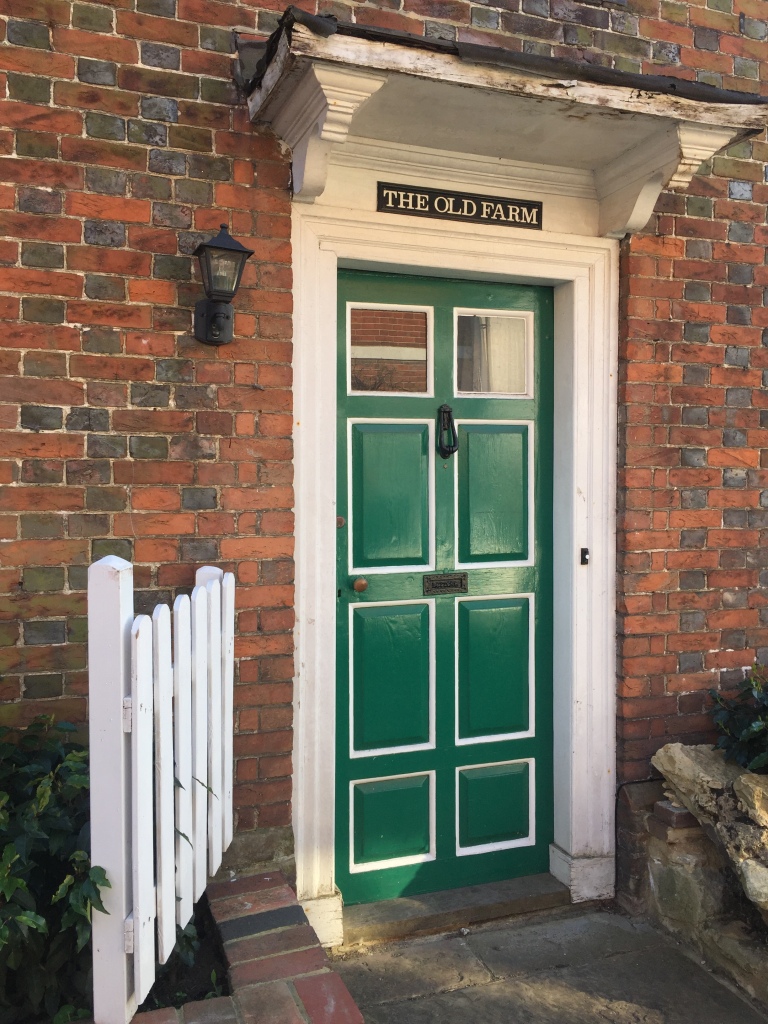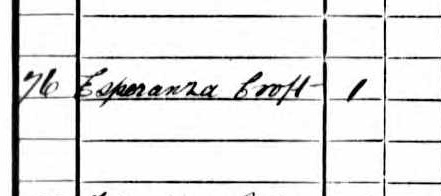



Does your house have a name or a number, or even both? According to the Land Registry in 2011, 1.4 million homes in towns and villages across England, (out of 26 million), have a name. Although they are in the minority, amongst a sea of numbers, they nevertheless form a significant one. When the population was smaller and more rural, it was not really necessary to use numbers at all. Names and signs on houses sufficed for identification. But during the 18th century, houses in many towns and cities gradually started to use a numbering system. Typically, houses on the left side of the street were assigned odd numbers, and houses on the right side, even numbers, with the lowest numbers usually nearest to the town centre.
Still, the allure of naming your home persisted, particularly as the growth of the railways in the 19th century led to the creation of new suburban housing. It was appealing to personalise your home in some way. This also happened with the big increase in home ownership in the interwar years and the growth of the middle class. Before then, homes were mostly rented, with only one in ten people being homeowners. By 1939, a quarter of homes were owner-occupied. These first proud homeowners wanted to name their new properties. This was the golden age of home ownership, as after the Second World War, the naming of houses fell into decline: more flats were built and fewer people constructed their own homes.
So what names do people give to their houses? It is common to find that the names of older houses reflect their original ownership or a local place name. Similarly, tradespeople often named their homes after their occupation. This is why there is an abundance of homes named Forge Cottage, the Old Bakery, or Mill House. Other names reflect the appearance of the house, such as “Crooked Cottage”, their surroundings, “Hillview”, or point to a previous use, “School House”.
As time went on, owners chose names for their houses merely because they sounded pleasant. They were made up entirely upon the whim of their owners. Inspiration was often taken from the names of plants and animals and are reminiscent of the countryside. They may be humorous too, such as “Two Hoots” or even contain a pun, (a fashionable choice in the the 1920s), such as “Dunroamin”. According to the Royal Mail, in 2015, the top ten most popular house names, (combined with Cottage, House, View etc.) were Orchard, Meadow, Rose, Holly, Oak, Willow, School, The Willows, Sunnyside, and Springfield.
Although a house can be named for any manner of reasons, I have also found that house names can sometimes have relevance to one’s family history. Names can be more meaningful than you may think and hold some significance to your research. Let me explain.
One branch of my family, the Powells, were living on the Isle of Wight from the 1840s. In 1895, my grandmother’s aunt, Emma Powell, a 29 year old housemaid, married Edmund Durnford, a 64 year old widower. Given the large age discrepancy, one wonders about their motivations. Was Emma in search of a comfortable life with a man with no dependants and a steady income? Was Edmund looking for a young wife to take care of him in his old age? Although I cannot be certain, I think this marriage could well have been a love match. The clue is in the name of their house:

Ancestry.co.uk

It is touching to see from the 1901 census that Edmund and Emma named their home, “Emma Cottage”. How romantic! All the other neighbouring houses on Pallance Road, Northwood, just have numbers. The couple were together until Edmund’s death in 1907. Emma married again the following year.
As a child, I spent many happy hours at my grandparents house, a small bungalow that my grandfather built ca. 1934, part of the big growth in house building prior to the Second World War. Their home was named “Belmont”, “beautiful mountain”. It’s an attractive name for a house but my aunt informs me that it was named “Belmont” after the home of my grandfather’s brother, Joe, who had emigrated to Australia in 1926. I thought that was that until I was browsing through the history of the town of Wantage, Berkshire, where my grandfather and his brother had spent their childhood, and discovered that Belmont is an area of the town. Did the brothers have happy memories of playing there as children, hence they both chose to name their homes “Belmont” on different continents of the world?
Looking at my husband’s ancestry, his ancestor, George Woodcock, a shipwright, moved with his wife, Mary Ann, and blind daughter, Hannah (Lilian), to Essex from the East End of London at the turn of the 20th century. George was an example of an upwardly mobile Victorian who had saved up sufficiently to buy his own home in the fresh air of an Essex country village. After retiring from shipbuilding, he change his lifestyle completely, spending his retirement keeping chickens. He can be found living with his family in the parish of Great Burstead, Essex at the time of the 1901 census:

Ancestry.co.uk

George Woodcock called his new home, “Esperanza Croft”. Esperanza means “hope” in Spanish. This might seem an unusual name for a house in Essex, built by a shipwright who had been born in the Scilly Isles, but had spent his working life in the East End docks. However, it makes sense if you know more about his family. George and Mary Ann also had a son, Stanley, (born 1877), who in 1898 decided to make his career as a merchant. Stanley travelled to the hot, tropical city of Tumaco on the Caribbean coast of Colombia, South America, where he set himself up in business. It must have been a huge wrench for his parents to let him go on this big adventure so they lived in hope, hope that he would survive, hope that they would see him again, hope that he would have a successful and happy life.
Not so long ago, I decided to travel to Great Burstead to track down “Esperanza”. I was delighted to find a house named “Esperanza” down a country lane on the outskirts of the village. It looked rather too modern to be the house recorded in the 1901 census, (and indeed in the 1911 census). Presumably though, a more modern house had been built on the same spot and the name had been retained. I knocked on the door of the house and introduced myself to the owner, telling her something of the history of the house. I was greatly amused when she told me that she believed the house had been named “Esperanza” because the previous owner had enjoyed holidays to Spain in the 1970s!
Close to the farm where I grew up in Higham, Kent, is a pair of semi-detached houses, called “1 & 2 Gordon Villas”. These houses replaced two cottages called “1 & 2 Waterworks Cottages” that originally belonged to my grandfather. In September 1940, during the Battle of Britain, fifteen bombs fell on Higham in one day, within a radius of half a mile. One bomb fell on one of the Waterworks Cottages, though thankfully, the occupants escaped serious injury. However, the cottages were no longer habitable and had to be demolished. In 1947, my grandfather built their replacements, 1 & 2 Gordon Villas. Poignantly, they are named after my grandfather’s son, Gordon. Uncle Gordon was an RAF pilot who served in the Battle of Britain but died as a prisoner of war in Hamburg in 1942. They therefore commemorate his memory though few people today know this history.
Names of houses are often sentimental, humorous, historic, or descriptive. Frequently, they were chosen by their owners to make a personalised statement, often about the house but sometimes also about themselves. The name may therefore contain clues to previous occupants and the things that were meaningful to them, as can be seen by the examples I have found in my own research. This is therefore worth considering when researching your own family history.
© Judith Batchelor 2020
Judith, Frankly you are a master in research on historical stories! I have enjoyed your new write up on a wonderfully written topic of the significance of “House Names to Family”. It is a beautifully written research on the subject matter and, the manner of bringing up the core of a highly interesting fact of the naming a house, which I am sure opens up a desire to dig deeper into the historical facts. I enjoyed your generosity to share the subject. Congratulations again! Michael.
LikeLiked by 1 person
Judith Thank you for your latest post, which was an interesting observation I will add that my house was called Colinbourne when we first moved here – for the reason that a previous owners son Colin was born here! We decided that was really cheesy so changed the name to Melville Lodge. Melville was a family name on Nigel’s side of the family, but ironically in doing research into the Anderson family there is a very distant connection to the third Earl of Melville in Scotland , so connections on both sides!! Hope that you are all staying well, I am. Love Heather
Sent from my iPad
>
LikeLiked by 1 person
That’s such a funny story. I can see why you changed the name. 😂
LikeLike
Judith – Interesting to know why our grandparents’ home was named “Belmont”. I once heard of a house name “Thistledome” – rather floral I thought, until I was told it was pronounced “This’ll do me” – rather along the lines of “Dunroamin”! Here in Kernow I find the Cornish house names pretty much unpronounceable to an incomer like me. Trish
LikeLiked by 1 person
“Thistledome”, I love it! I imagine most Cornish house names are pretty incomprehensible unless you are a native.
LikeLike
Another great post! So interesting. thank you!
LikeLiked by 1 person
Both my great grandpa & his daughter called their houses in Bournemouth and Glasgow, Roselyn. My great grandma who had died earlier was Rose and the family had lived in Kings Lynn.
LikeLiked by 1 person
It makes a pretty combination!
LikeLiked by 1 person
Thanks for the mention Clare! I really enjoyed your article on surnames used as middle names. You have some wonderful examples from your own research and as you explain, there can be quite a few different reasons why they were given. In some cases, they were also hyphenated. Hyphenated names can be tricky to find in indexes, as you never know if they are indexed under the first or second surname.
LikeLike
A minor NB: Belmont means ‘beautiful mountain’. Belvue means ‘beautiful view’.
LikeLiked by 1 person
Of course, thank you, I’ll make the correction.
LikeLike